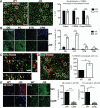Complement and microglia mediate early synapse loss in Alzheimer mouse models
- PMID: 27033548
- PMCID: PMC5094372
- DOI: 10.1126/science.aad8373
Complement and microglia mediate early synapse loss in Alzheimer mouse models
Abstract
Synapse loss in Alzheimer's disease (AD) correlates with cognitive decline. Involvement of microglia and complement in AD has been attributed to neuroinflammation, prominent late in disease. Here we show in mouse models that complement and microglia mediate synaptic loss early in AD. C1q, the initiating protein of the classical complement cascade, is increased and associated with synapses before overt plaque deposition. Inhibition of C1q, C3, or the microglial complement receptor CR3 reduces the number of phagocytic microglia, as well as the extent of early synapse loss. C1q is necessary for the toxic effects of soluble β-amyloid (Aβ) oligomers on synapses and hippocampal long-term potentiation. Finally, microglia in adult brains engulf synaptic material in a CR3-dependent process when exposed to soluble Aβ oligomers. Together, these findings suggest that the complement-dependent pathway and microglia that prune excess synapses in development are inappropriately activated and mediate synapse loss in AD.
Copyright © 2016, American Association for the Advancement of Science.
Figures




Comment in
-
Neurodegenerative disease: Complement mediates pathological pruning.Nat Rev Neurosci. 2016 Jun;17(6):336. doi: 10.1038/nrn.2016.52. Epub 2016 Apr 21. Nat Rev Neurosci. 2016. PMID: 27098771 No abstract available.
References
-
- Stevens B, et al. The classical complement cascade mediates CNS synapse elimination. Cell. 2007;131:1164–1178. - PubMed
Publication types
MeSH terms
Substances
Grants and funding
LinkOut - more resources
Full Text Sources
Other Literature Sources
Medical
Molecular Biology Databases
Miscellaneous

